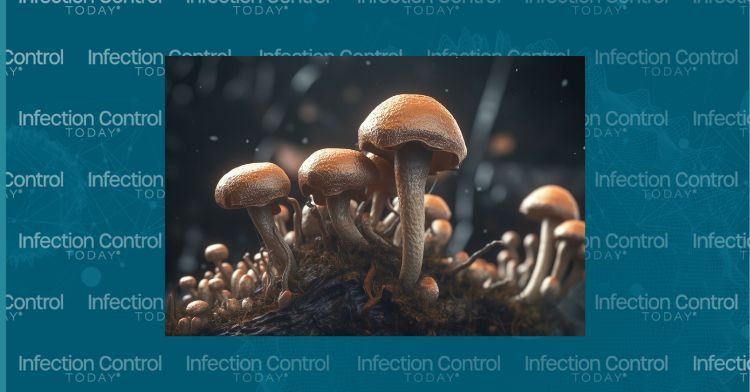Fungus Among Us: The Rising Threat of Candida auris in Health Care Settings and How to Mitigate It
A presentation at the Disease Prevention and Control Summit in Philadelphia, Pennsylvania, spoke about the rising threat of Candida auris.
3D illustration: Candida auris
(Adobe Stock 635576411 By Niamh)

Insights from a Public Health Leader
I recently attended the Disease Prevention and Control Summit—America and World AMR [Antimicrobial Resistance] Congress in Philadelphia, held September 5 and 6, 2024. At this conference, I listened to a talk titled Candida auris: Turning Challenges into Successes at Your Healthcare Facility, presented by Julie Paoline, MA, CPHA, CIC, FAPIC, a public health expert at the Pennsylvania Department of Health.
C auris is an emerging pathogen that poses a significant threat to healthcare facilities. It is currently listed under the CDC 2019 Antibiotic Resistance Threats Report as an urgent threat due to its resistance to common antifungal agents, its ability to cause indefinite colonization in affected patients and its high potential for outbreaks in health care facilities.
Some of the main risk factors for C auris infection in patients include immunocompromised status, extended length of stay, and persistent colonization. Environmental risk factors within the health care setting also contribute to the persistence of this organism. They include the pathogen’s ability to form biofilms on environmental surfaces and objects, making it resistant to standard cleaning and disinfection practices and suboptimal infection prevention practices such as inadequate hand hygiene, personal protective equipment (PPE) use, and cleaning and disinfection practices.
Courtesy of Julie Paoline, MA, CPHA, CIC, FAPIC, and the CDC from https://url.us.m.mimecastprotect.com/s/c1U6CpYPqPtqnX08SPf7CGPjT2?domain=cdc.gov

Current C auris Impact and Significance
2022 is reported to be the first year of complete national-level data in the US: 2,377 clinical cases and 5,754 screening cases were identified. The CDC’s definitions for clinical versus screening cases can be found here. Additionally, C auris is reported to cause a 50% mortality rate in the US; 86% of isolates are reportedly resistant to azole antifungals, and there is currently no known decolonization process, which increases the potential for outbreaks from colonized patients.
When first introduced into the US, C auris cases were seen among patients who recently reported a history of travel and health care visits internationally. Currently, there is evidence of an increase in local transmission rather than international healthcare exposure, indicating that the pathogen is now endemic to the US.
These staggering facts and the apparent evolution of this organism raise concern and demonstrate the importance of health care professionals remaining alert and taking precautions within their facilities.
"In US health care facilities, C auris is introduced by colonized patients from high burden areas. The first case in a region may be the tip of the iceberg. We are urging all healthcare facilities to take action to enhance detection methods now," Paoline said.
Here are some proactive measures that health care professionals can take:
Detection and Surveillance
Wastewater surveillance has become a valuable tool for detecting C auris. Its presence in wastewater may suggest the presence of active cases of infection or colonization or the presence of residual biofilms from previous outbreaks in affected regions. Additionally, wastewater surveillance could also indicate the presence of C auris in health care facilities or communities.
Public Health Recommendations and Mitigation Strategies
To reduce the spread of C auris, health care facilities should:
- Provide ongoing education on C auris prevention methods for health care professionals and patients
- Strengthen infection prevention practices with a strong focus on strict hand hygiene measures and proper cleaning and disinfection practices with the use of EPA-registered disinfectants effective against C auris (List P)
- Conduct admission screening to detect colonized individuals and ensure prompt isolation precautions.
- Facilitate communication and coordination during interfacility patient transfers.
Courtesy of Julie Paoline, MA, CPHA, CIC, FAPIC

Success Stories
The Pennsylvania Department of Health has successfully worked with 2 short-term acute care hospitals to implement admission screening programs. These initiatives have proven effective in detecting C auris early in the admission process and preventing its spread.
As C auris continues to present a significant threat to employee and patient safety, health care facilities must stay alert and implement robust infection prevention strategies. As Paoline recommended in her talk, focusing on early case detection, proper infection control practices, and effective departmental and interfacility communication can help mitigate the impact of this dangerous pathogen.
Show, Tell, Teach: Elevating EVS Training Through Cognitive Science and Performance Coaching
April 25th 2025Training EVS workers for hygiene excellence demands more than manuals—it requires active engagement, motor skills coaching, and teach-back techniques to reduce HAIs and improve patient outcomes.
The Rise of Disposable Products in Health Care Cleaning and Linens
April 25th 2025Health care-associated infections are driving a shift toward disposable microfiber cloths, mop pads, and curtains—offering infection prevention, regulatory compliance, and operational efficiency in one-time-use solutions.
Phage Therapy’s Future: Tackling Antimicrobial Resistance With Precision Viruses
April 24th 2025Bacteriophage therapy presents a promising alternative to antibiotics, especially as antimicrobial resistance continues to increase. Dr. Ran Nir-Paz discusses its potential, challenges, and future applications in this technology.